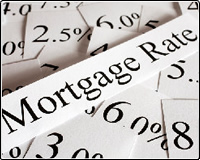Home prices in 20 U.S. cities climbed in June for the first time since a tax credit boosted sales in 2010, indicating the industry at the heart of the worst recession in the post-World War II era is starting to rebound.
 The S&P/Case-Shiller index increased 0.5 percent from June 2011 after falling 0.7 percent in the year to May, a report from the group showed today in New York.
The last 12-month increase took place in September 2010. Nationally,
prices jumped last quarter by the most in more than six years.
The S&P/Case-Shiller index increased 0.5 percent from June 2011 after falling 0.7 percent in the year to May, a report from the group showed today in New York.
The last 12-month increase took place in September 2010. Nationally,
prices jumped last quarter by the most in more than six years.
The lowest mortgage rates
on record and a decline in sales of distressed properties may help the
market contribute to the economic expansion that is now in its fourth
year. A more sustained rebound may require easier lending conditions,
which would also give consumers a lift after a report today showed
household confidence sank to the lowest level of the year.
“Finally,
the housing market is forming a bottom,” Mohamed El-Erian, chief
executive officer and co-chief investment officer of Pacific Investment
Management Co., said on Bloomberg Television’s “In the Loop” with Betty Liu. “That should be welcome. It is not surprising because affordability is so attractive right now.”
Stocks were little changed as investors weighed the economic reports ahead of Federal Reserve Chairman Ben S. Bernanke’s
speech on the economy in three days. The Standard & Poor’s 500
Index fell less than 0.1 percent to 1,409.3 at the 4 p.m. close in New
York.
Housing Overseas
Overseas, housing markets aren’t faring as well. Sales of newly built homes in Australia dropped in July to the second- lowest level on record, a report today showed.
In Europe, figures today showed Spain’s
recession worsened in the second quarter as the government’s austerity
measures to reduce the euro area’s third-biggest budget deficit and a
slump in consumer spending offset growth in exports.
The
S&P/Case-Shiller 20-City index was projected to drop 0.05 percent
in the year to June, according to the median forecast of 29 economists
surveyed by Bloomberg. Estimates ranged from declines of 1.5 percent to a
1 percent gain. The index is based on a three-month average, which
means the June data were influenced by transactions in April and May.
Year- over-year records began in 2001.
In an effort to boost home
sales, lawmakers gave first-time homebuyers a tax credit worth up to
$8,000 as part of the 2009 stimulus package. The break expired April 30,
2010, indicating the recent gains in sales are sustainable.
More Gains
“This
ain’t tax credit driven,” said Thomas Lawler, a former Fannie Mae
economist who is now a Virginia-based housing consultant. “There are
fundamental reasons to expect home prices have bottomed and will
continue to show gains.”
Consumer confidence
fell in August as households grew more pessimistic about their
employment prospects and the economic outlook, another report today
showed. The Conference Board’s index
decreased to 60.6, the lowest level since November, from a revised 65.4
in July, according to data from the New York-based private research
group. The 4.8-point decrease was the biggest since October. The reading
was less than the most-pessimistic forecast in a Bloomberg survey in
which the median projection was 66.
Susan Wachter, professor of real estate and finance at the University of Pennsylvania’s
Wharton School, said the increase in prices will help aid consumer
confidence, in turn benefiting other parts of the economy.
‘Real’ Rebound
“This is real,” Wachter said. “The market has turned and barring any new shocks, this should continue.”
Today’s
home price figures also included quarterly national data. Property
values in all the U.S. increased 1.2 percent in the second quarter from
the same time in 2011 compared with a 1.4 percent drop in the year ended
March. They jumped 6.9 percent from the previous three months before
seasonal adjustment. The gauge increased 2.2 percent after taking those changes into account, the best performance since the fourth quarter of 2005.
Home
prices in the 20 cities adjusted for seasonal variations increased 0.9
percent in June from the prior month. Unadjusted prices climbed 2.3
percent from the previous month.
The year-over-year gauge provides better indications of trends in prices, the group has said. The panel includes Karl Case and Robert Shiller, the economists who created the index.
Broad Pickup
“The whole market in the process of a pickup -- it’s the little engine that could,” Case told Tom Keene and Ken Prewitt on Bloomberg Radio today. “It’s chugging along at a reasonable rate.”
Thirteen
of the 20 cities in the index showed a year-over- year gain, led by a
14 percent increase in Phoenix. Atlanta had the biggest year-over-year
drop, with prices falling 12 percent.
The swing in property
values from a decline last year to a gain in 2012 will provide
“meaningful support” to economic growth as rising home prices boost
household wealth, economists at UBS Securities LLC wrote in an Aug. 24
research note. The improvement may boost consumer spending by as much as
0.5 percentage point at an annual rate, helping the world’s largest
economy expand by 2.1 percent this year and 2.3 percent in 2013, they
wrote.
Toll Brothers Inc. (TOL),
the largest U.S. luxury-home builder, reported a better-than-estimated
profit and an increase in revenue for its third quarter ended July 31.
The average price of the homes that the Horsham, Pennsylvania-based
company delivered in the quarter climbed to $576,000 from $557,000 in
the previous three months.
‘Pent-Up Demand’
“The housing recovery is being driven by pent-up demand, very low interest rates
and attractively priced homes,” Chief Executive Officer Douglas Yearley
Jr. said on an Aug. 22 conference call with investors. “With an
industry wide shortage of inventory in many markets, we are enjoying
some pricing power.”
Recent reports also indicate a pickup in demand. Purchases of new homes rose more than projected in July to match a two- year
high, Commerce Department data showed last week. Previously-owned house
sales rebounded from an eight-month low, the National Association of
Realtors reported.
Prices are improving in part because
distressed homes are making up a smaller portion of sales. Distressed
sales accounted for 24 percent of existing-home purchases in July, the
Realtors data showed. That’s less than the prior month and down from 29
percent in July 2011. Such sales are comprised of foreclosures and short
sales, in which the lender agrees to a transaction for less than the
balance of the mortgage.
Fewer Foreclosures
There were 58,000 foreclosures in July, down from 69,000 a year earlier, CoreLogic Inc. said in a report today.
“The
decline in completed foreclosures is yet another positive signal that
the housing market is continuing on a progressive path of stabilization
and recovery,” Anand Nallathambi, president and chief executive officer
of Santa Ana,
California-based CoreLogic said in a statement. “Alternative
resolutions are helping to reduce foreclosures and often result in a
more positive transition for the borrower and lower losses for investors
and lenders.”
The views,
opinions, positions or strategies expressed by the authors and those providing
comments or external internet links are theirs alone, and do not
necessarily reflect the views, opinions, positions or strategies of First
Capital, we make no representations as to accuracy, completeness, current,
suitability, or validity of this information and will not be liable for
any errors, omissions, or delays in this information or any losses, injuries,
or damages arising from its display or use. Any information
provided does not constitute an offer or a solicitation to lend. Providing
information to purchase does not guarantee a loan approval. All registered trademarks, copyright,
images, or other items used are property of their respective owner and are used
for editorial purposes only.
First
Capital Mortgage is a subsidiary of PHH Home Loans LLC, a direct lender, Dept.
of Corporations file #413-0713 NMLS#4256
Visit First Capital Online
or call: 310-458-0010












































